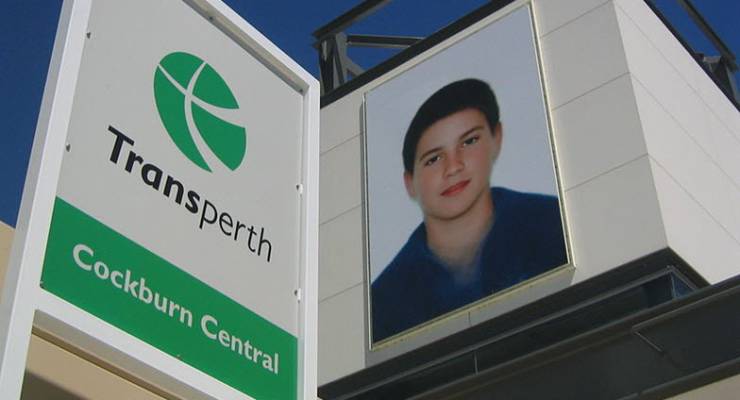
For more than a decade, an elderly woman and an adolescent boy have watched over the West Australian suburb of Cockburn. Perhaps unsurprisingly, their blank gazes have unsettled many residents.

The origin of the faces, which adorn opposite sides of a tower above Cockburn train station, are unclear upon first glance. But the mural, The Face of the Community, is in fact a digital amalgamation of hundreds of local residents. It was completed 13 years ago by artists Marco Marcon and Rodney Glick, and has caused controversy ever since.
Every now and then a petition makes the rounds, calling on the local government to end this Sauron-esque watch over the townspeople — the most recent of which received hundreds of signatures last year. A Facebook page titled “Remove the Cockburn train station face” has racked up nearly 10,000 likes.
It’s not hard to understand why some people find it disturbing. The digitally-produced images edge on the uncanny valley, a concept that suggests there is a thin boundary between a convincing duplication of a human face and a slightly off replica that repulses the viewer (think of the human-adjacent animations from The Polar Express). Many residents and passersby also don’t know the idea behind the works.
When asked about the ongoing backlash, Macron tells Crikey that this was deliberate; the artists wanted to keep viewers curious.
“The artwork’s main idea was to create a billboard that — instead of using the human face to sell a political party, a real estate agency, this or that consumerist product — simply represented the people living in the area,” he says.
“Why so little information from us? Because we wanted people to think and question the nature of advertising, the public celebration of specific individuals, the way in which media technology creates fake faces of fake heroes.”
It seems to have worked. In a vox pop conducted by Perth radio station 92.9FM, some punters thought the faces were those of missing residents, like milk carton kids (or octogenarians in this case). Online commenters shared their own hypotheses.
“I thought it was Daniel Microbe [sic] the boy that went missing years [ago] ok but I could be wrong,” one Facebook user wrote.
“I always thought this was a paedophile that parents and children needed to look out for,” another local said.
The Face of the Community stands alongside a slate of other odd artworks in Perth, each thought-provoking and/or ridiculed in their own way. Sitting in Forrest Place, a major shopping precinct in the CBD, is Grow Your Own, a bright green sculpture resembling a cartoon cactus. The $1 million procurement from the state government is affectionately nicknamed the “Angus Alien” after the artist James Angus — or simply “the cactus”. The iconic Perth bell tower, after which a satirical publication and Facebook page is named, has wings that wrap around the spire like a cockroach.
Many culture snobs will say good art should challenge you, which is exactly what The Face of the Community does. And it’s far from the first public artwork to cause such controversy. Think of Ron Robertson-Swann’s Vault in Melbourne. Think of Sydney’s now-abandoned Cloud Arch. Think of the Skywhale.
Besides, if we were tossing out art that looked “ugly”, half of all medieval art would be the first to go. Some of those painters acted like they’d never seen a human infant in their lives but decided to give it a crack anyway. Look up Paolo Veneziano’s Madonna With Child and you’ll understand.
Marcon says he and Glick were initially surprised by the negative response to their work, but they have since come to realise why. “Even though the internet makes it incredibly fast and easy to find information about anything, it’s still easier to offer an uninformed opinion on social media,” he says.
The Public Transport Authority recently says it has no plans to remove the artwork, and has in fact received support from both the local council and community groups in the past to keep it up. If this kind of ongoing reflection and debate is the metric of success for Australian public art, The Face has certainly earned its right to keep watch.
Over the summer months, Crikey has been sharing occasional stories from small communities around Australia. You can read more here.







“Some of those painters acted like they’d never seen a human infant in their lives but decided to give it a crack anyway”
Hahahaha!!
Many people enjoy this moment of art viewed from the freeway as it has helped humanize a raw ,new development rich in roads, concrete and aggressive advertising.
I am reminded of the inexplicably unpleasant visages that can be created by dividing a face in half and duplicating it to form a single face – the difference between a “double right” & “double left” face is very striking and oddly upsetting.